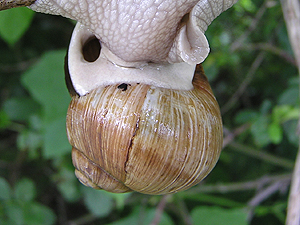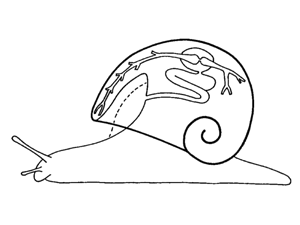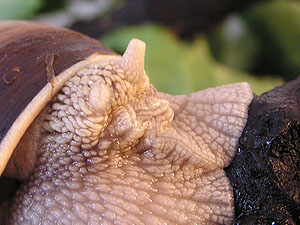
Apertural view of a living snail. From this point of view the
mantle and the respiratory opening can especially well be
seen. [RN]
 Apertural view of a living snail. From this point of view the mantle and the respiratory opening can especially well be seen. [RN] |
It was the capability to breathe oxygen from the air that finally enabled today's terrestrial molluscs' ancestors to move on dry earth. This transition happened several times in separated cases and in different systematic groups of gastropods. All, however, whatever their systematic origin, have in common that they breathe dry air.
Basically all molluscs breathe by gills that are called ctenidia (comb-gills) because of their comb-like shape. In terrestrial molluscs this respiration organ is reduced, but still respiration takes place in the pallial cavity. That is why it is also called the snail's respiratory cavity.
Externally the mantle cavity is recognised by its large entrance opening, the respiratory opening or pneumostome. It can be seen on the right side of the mantle in the shell aperture, opening and closing periodically. When the snail is not breathing, it closes its pneumostome with a circular muscle, to avoid losing to much water by evaporation.
 The process of breathing in a Roman snail: The mantle cavity floor is used like a human diaphragm. Source: Kilias (1985). |
To inhale, the snail widens the respiratory cavity by lowering the cavity floor. Due to the resulting low pressure, air rich in oxygen flows into the cavity (see illustration on the right).
Gas exchange takes place at the cavity's roof. There the tissue is particularly thin, so oxygen (O2) diffuses into the blood fluid circulating there. In the opposite direction carbon dioxide (CO2) diffuses from the blood into the air, following the gradient of gas contained in air and blood respectively. To assist this gas exchange, the snail closes the pneumostome and raises the cavity floor, thus increasing pressure inside the pallial cavity and the rate of oxygen diffusion into the blood.
To exhale the depleted air, the snail finally opens the pneumostome and raises the cavity floor to press out the air. So the respiratory cavity floor performs the same task as does the human diaphragm in respiration.
This described respiratory organ of the Roman snail is called its lung, in analogy to the human lung, though it resembles a single alveole, more than the whole organ of a vertebrate's lung. The Roman snail, Helix pomatia, because it breathes oxygen from dry air with such a snail lung, is placed systematically in the group of lung snails or pulmonate snails (Pulmonata). Those not only live on dry land, but also in fresh water. There they are optimally adapted to the sometimes changeful environmental conditions.
 The heart and neighbouring organs of a Ro- man snail. Source: Kilias (1985). |
A Roman snail's heart is located in the heart-bag (pericardium) at the upper mantle rim, behind the respiratory cavity. It is divided into two chambers, an atrium and a ventricle, both connected by a narrow duct, a valve avoiding blood fluid flowing back.
A Roman snail's heartbeat frequency very much depends on the snail's body temperature and activity. It ranges from 70 to 80 beats per minute in an awake and active snail to about 5 beats per minute during aestivation, but especially during hibernation.
When the snail's blood flows back to the lung, depleted from oxygen, it is almost colourless. After the blood has been loaded with oxygen again, its colour changes to blue. The reason, why a Roman snail's blood is blue, is the snail's blood pigment – haemocyanin. Similar to haemoglobin it is a protein working as a complex with an inorganic atom, to which the oxygen molecule is supposed to bind. Contrary to haemoglobin, though, this inorganic atom in haemocyanin is copper, which appears blue in its oxidised state, but colourless, when reduced.
 To stretch withdrawn tentacles, the Roman snail applies hy- draulic blood pressure. [RN] |
Like in most other molluscs, the snail's blood circulation is basically open: From the heart the blood flows through the main artery, the aorta, into the body. The aorta branches into numerous smaller arteries, which supply different parts of the body with blood. The smallest of blood vessels, the capillaries, however, are open – the blood flows into the body cavity and around the organs, which thereby it supplies with oxygen. Capillary veins suck blood from the body cavity and transport it back to the lung, where it is to be reloaded with oxygen.
An open circulation, such as in a Roman snail's body, basically can be found in all molluscs. Only the most highly developed cephalopods (Cephalopoda), such as octopuses (Octopodidae), possess a mostly closed circulation.
Finally, a snail's blood not only transports respiration gases. It also gives form and firmness to the snail's soft body, which, the snail being a mollusc, lacks a skeleton. As it is the blood responsible for the body's firmness, it is also usually referred to as a hydroskeleton.
Additionally the blood fluid of a snail is used to stretch out withdrawn parts of the body by hydraulic pressure. So for example, when a tentacle has been withdrawn by the action of a retractor muscle, it must be stretched again by pumping blood into its hollow interior.